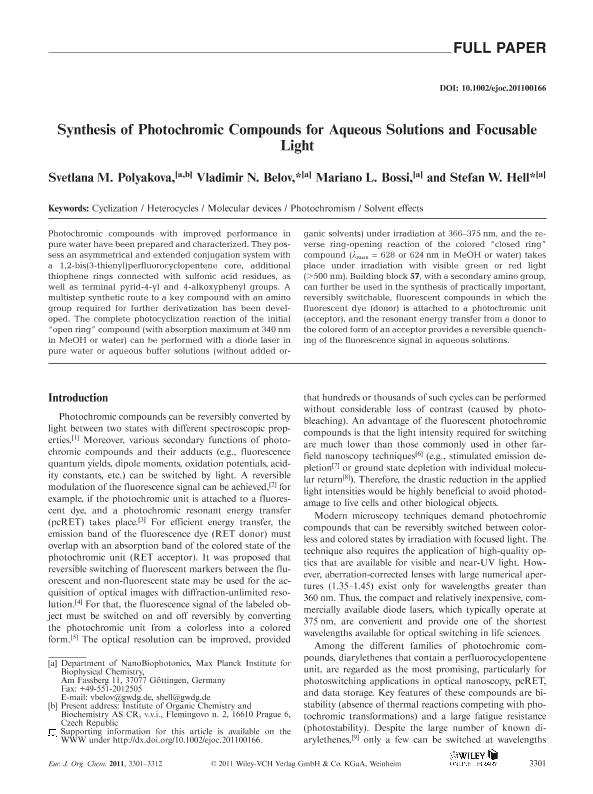Mostrar el registro sencillo del ítem
dc.contributor.author
Polyakova, Svetlana M.
dc.contributor.author
Belov, Vladimir N.
dc.contributor.author
Bossi, Mariano Luis

dc.contributor.author
Hell, Stefan W.
dc.date.available
2019-03-18T17:38:20Z
dc.date.issued
2011-06
dc.identifier.citation
Polyakova, Svetlana M.; Belov, Vladimir N.; Bossi, Mariano Luis; Hell, Stefan W.; Synthesis of photochromic compounds for aqueous solutions and focusable light; Wiley VCH Verlag; European Journal of Organic Chemistry; 18; 6-2011; 3301-3312
dc.identifier.issn
1434-193X
dc.identifier.uri
http://hdl.handle.net/11336/71874
dc.description.abstract
Photochromic compounds with improved performance in pure water have been prepared and characterized. They possess an asymmetrical and extended conjugation system with a 1,2-bis(3-thienyl)perfluorocyclopentene core, additional thiophene rings connected with sulfonic acid residues, as well as terminal pyrid-4-yl and 4-alkoxyphenyl groups. A multistep synthetic route to a key compound with an amino group required for further derivatization has been developed. The complete photocyclization reaction of the initial "open ring" compound (with absorption maximum at 340 nm in MeOH or water) can be performed with a diode laser in pure water or aqueous buffer solutions (without added or-ganic solvents) under irradiation at 366-375 nm, and the reverse ring-opening reaction of the colored "closed ring" compound (λmax = 628 or 624 nm in MeOH or water) takes place under irradiation with visible green or red light (>500 nm). Building block 57, with a secondary amino group, can further be used in the synthesis of practically important, reversibly switchable, fluorescent compounds in which the fluorescent dye (donor) is attached to a photochromic unit (acceptor), and the resonant energy transfer from a donor to the colored form of an acceptor provides a reversible quenching of the fluorescence signal in aqueous solutions. © 2011 Wiley-VCH Verlag GmbH & Co. KGaA, Weinheim.
dc.format
application/pdf
dc.language.iso
eng
dc.publisher
Wiley VCH Verlag

dc.rights
info:eu-repo/semantics/openAccess
dc.rights.uri
https://creativecommons.org/licenses/by-nc-sa/2.5/ar/
dc.subject
Cyclization
dc.subject
Heterocycles
dc.subject
Molecular Devices
dc.subject
Photochromism
dc.subject
Solvent Effects
dc.subject.classification
Otras Ciencias Químicas

dc.subject.classification
Ciencias Químicas

dc.subject.classification
CIENCIAS NATURALES Y EXACTAS

dc.title
Synthesis of photochromic compounds for aqueous solutions and focusable light
dc.type
info:eu-repo/semantics/article
dc.type
info:ar-repo/semantics/artículo
dc.type
info:eu-repo/semantics/publishedVersion
dc.date.updated
2019-03-08T20:15:51Z
dc.journal.number
18
dc.journal.pagination
3301-3312
dc.journal.pais
Alemania

dc.journal.ciudad
Weinheim
dc.description.fil
Fil: Polyakova, Svetlana M.. Max Planck Institute for Biophysical Chemistry; Alemania. Institute of Organic Chemistry and Biochemistry; Alemania
dc.description.fil
Fil: Belov, Vladimir N.. Max Planck Institute for Biophysical Chemistry; Alemania
dc.description.fil
Fil: Bossi, Mariano Luis. Consejo Nacional de Investigaciones Científicas y Técnicas; Argentina. Max Planck Institute for Biophysical Chemistry; Alemania
dc.description.fil
Fil: Hell, Stefan W.. Max Planck Institute for Biophysical Chemistry; Alemania
dc.journal.title
European Journal of Organic Chemistry

dc.relation.alternativeid
info:eu-repo/semantics/altIdentifier/doi/https://doi.org/10.1002/ejoc.201100166
dc.relation.alternativeid
info:eu-repo/semantics/altIdentifier/url/https://onlinelibrary.wiley.com/doi/abs/10.1002/ejoc.201100166
Archivos asociados
